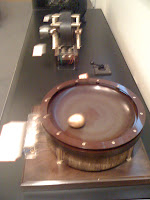After visiting Kalemegdan, Knez Mihailova Street, St Sava Church and quaint Skadarlija, there are some fine museums to explore;
Nikola Tesla Museum We are all used to neon lights and remote controls nowadays, but it’s amazing to see the work that the Serbian scientist Tesla did back in the 19th century and how much he was ahead of his time - Tesla invented electricity and Edison copied his work. There are all type of models, displays and several exceptionally valuable collections in the museum.
Website: www.tesla-museum.org

Ethnographic Museum One of the oldest museum in the Balkans with different folk costumes, textiles, embroidery, lace, musical instruments, furniture and art from all around Serbia. The permament exhibit takes up three levels of the building. The first floor represents the popular assembly, the second is related to textile production and the third is about culture of living. The symbol of the musuem is the Decanska Fountain located at its centre. Website: http://www.etnografskimuzej.rs/

Military Museum I love this Museum! It's located at the heart of the Kalemegdan Fortress and you can’t miss it as outside the main entrance are a row of tanks and cannons. The 3,000 exhibits date from ancient times through the medieval era then towards more modern times, so there are Roman swords, Greek helmets, knights' armour, axes, shields, guns, badges and uniforms, and it's latest acquisition, parts of a US F-117 stealth aircraft which was downed by Serbian forces during the 1999 NATO bombing. Webiste: http://www.muzej.mod.gov.rs/
National Museum Once one of the best Museums in the region has been more or less closed for refurbishment for the last 8 years, but the 3rd floor however is open and hosts an art gallery displaying just part of a very large collection of national and regional art. The most precious part of the collection consists of drawings of French and west-European artists of the 19th century and include C. Corot (Meadow by the Swamp), E. Degas (from the series Ballerinas and Women at Toilet), P-A. Renoir (from the series Guitar Players, c. 1897), C. Pissarro (Market at Pontoise), J-L. Forain (from the series Satirical Scenes), P. Picasso (Interior with Three Figures, 1926). Also work of Mattisse ( head of Women, 1939) and Rodin ( Female Nude, 1905) can be found here. Website: http://www.narodnimuzej.rs/
Tito’s Museum or The Museum of Yugoslav History, or the House of Flowers I am sentimentally fond of this museum even though my first visit was only last year when I took my friends from London to visit it. I was born and grew up under Tito's regime and remember when he died the whole country came to a standstill, rightly worried what would happen now that he was gone. He died in Slovenia and transferred to Belgrade's House of Flowers as it was known then for his final rest. At the beginning there were guards in very nice shiny uniforms giving the whole place a sense of importance, but nowadays the guards have been abolished and there is only one security guard in a small office on site. The graveyard is very simple – white marble with his name and date of birth and death, in gold. Some sceptics are saying that he wasn’t communist as there is no star on his grave, the communist symbol he fought for all his life. The place is interesting as it has a huge collection of relay batons, some of them dating back to 1945 when organised mass youth relays across Yugoslavia were common practice to express dedication to communism, Tito and the Party. Not far from Tito’s grave there is a permanent exhibition of the presents Tito received from dignitaries in Yugoslavia and abroad. I love a richly engraved 16th century sword from Iran.
The museum used to have more space before Milosevic moved into the neigbourghhood and decided to take part of the land from Tito's residence. Now on the right side there is a big brick wall and sometimes you can see part of the empty Milosevic residence. Outside the Museum in the main building there is a huge space which usually is used for exhibitions. webiste: www.mij.rs
Museum of Serbian Orthodox Church It’s worth mentioning a visit to the Museum of the Serbian Orthodox Church which is situated opposite the Cathedral Church of St. Michael the Archangel. A few years ago the Royal Academy of Art in London organized very successful exhibition called Byzantium where exhibits from the Museum of the Serbian Orthodox Church were on display. Today the exhibits can be found in Belgrade and also a large number of icons, church textiles, metal liturgy objects, manuscripts and old printed church books, portraits, graphics, etc. dating back to the 13th century. Webiste: http://www.spc.rs/
Among other museums there is the Historical Museum of Serbia (http://www.imus.org.rs/ ) situated not far from the Ethnographic Museum and which hosts a large collection of Serbian flags and military badges. Also it's worth mentioning the Aviation Museum (http://www.muzejrv.org/ ) situated near Airport Nikola Tesla, the Museum of Natural History (http://www.nhmbeo.rs/) situated at Kalemegdan Fortress and which is well known for hosting very unusual exhibitions. I would also mention the Railway Museum (www.zeleznicesrbije.com)
close to the Railway Station for enthusiastic trainspotters.
For private guided tour in Belgrade please email Tara@ReadyClickAndGo.com or check our website at www.ReadyClickAndGo.com



No comments:
Post a Comment